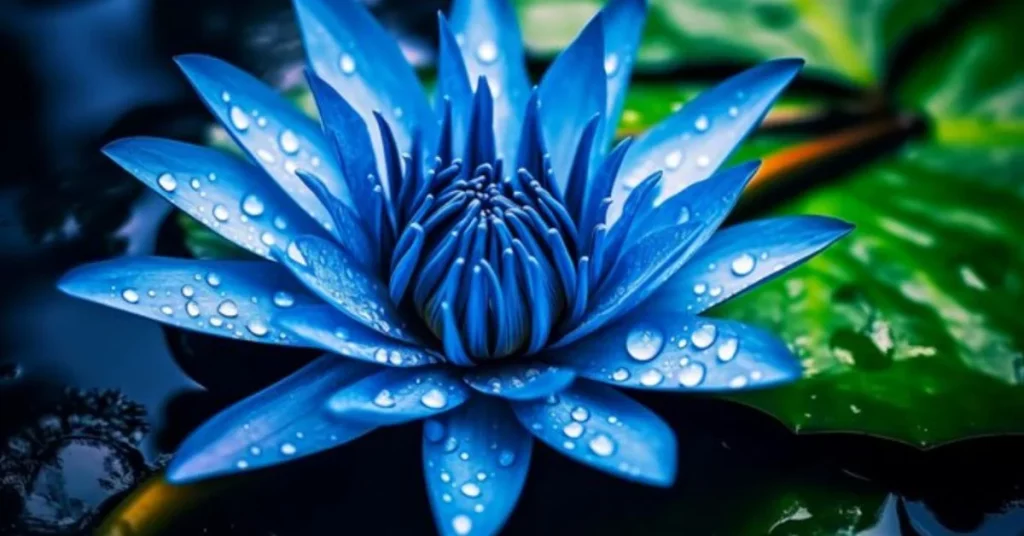Blue lotus, scientifically known as Nymphaea caerulea, is a majestic aquatic plant with profound cultural and historical significance. Revered for its enchanting beauty and therapeutic properties, the blue lotus has captivated civilizations for centuries.
Introduction to Blue Lotus
The blue lotus holds a revered place in various ancient cultures, including those of Egypt and ancient Greece. Depicted in religious ceremonies, art, and literature, it symbolizes spiritual enlightenment, tranquility, and rejuvenation. Historically, it was used in rituals and ceremonies for its psychoactive effects and revered as a symbol of purity and transcendence.
Botanical Profile
The blue lotus is a water lily belonging to the Nymphaeaceae family. It boasts delicate, sky-blue petals that float gracefully on the surface of calm waters. The plant’s leaves are broad and circular, providing shelter for aquatic creatures. Blue lo,tus flowers bloom during the day and close at night, adding to their mystical allure.
Cultural and Historical Significance
In ancient Egypt, the blue lo,tus was associated with the sun god Ra and used in religious ceremonies and medicinal preparations. The plant was believed to bring about euphoria, heightened awareness, and lucid dreaming. Similarly, in ancient Greece, it was linked to the goddess Aphrodite and believed to inspire love, fertility, and creativity.
Blue Lotus Benefits
Blue l,otus is renowned for its medicinal properties, with traditional uses ranging from pain relief and anxiety reduction to promoting relaxation and inducing sleep. It contains compounds such as alkaloids and flavonoids that contribute to its therapeutic effects.
ALSO READ: EVERYTHING ABOUT SPARROW FROST BLACK
Psychoactive Properties
The blue lotus exerts mild psychoactive effects, primarily due to the presence of alkaloids like nuciferine and aporphine. These compounds interact with neurotransmitter systems in the brain, leading to feelings of euphoria, tranquility, and heightened sensory perception.
Modern Applications
In modern times, blue lo,tus continues to be valued for its therapeutic potential. It is used in herbal medicine to alleviate stress, anxiety, and depression. Additionally, it is incorporated into wellness practices such as aromatherapy, massage oils, and herbal teas for its calming and mood-enhancing properties.
Cultivation and Harvesting
Blue lotus thrives in aquatic environments with still or slow-moving water. Cultivation typically involves planting seeds or rhizomes in shallow ponds or containers. Harvesting the flowers is done by hand when they are in full bloom, usually during the summer months.
Forms of Consumption
Blue lotus can be consumed in various forms, including teas, tinctures, extracts, and capsules. Some prefer smoking the dried petals or using them in aromatherapy preparations for their soothing fragrance.
Safety and Side Effects
While generally considered safe when used responsibly, blue lo,tus may cause mild side effects such as dizziness, nausea, and gastrointestinal discomfort in some individuals. It is essential to use caution and consult with a healthcare professional before incorporating it into your wellness regimen.
ALSO READ: WHISPERS OF NATURE: THE AUTOBÀ CHRONICLES
Legal Status
The legal status of blue lotus varies by region, with some countries regulating its sale and consumption due to its psychoactive properties. It is essential to research and understand the laws governing its use in your area before purchasing or using blue lo,tus products.
Blue Lotus in Art and Literature
Throughout history, the blue lo,tus has inspired artists, poets, and writers with its ethereal beauty and symbolic significance. From ancient sculptures and paintings to modern literature and films, it continues to evoke a sense of wonder and reverence.
Alternative Names
Blue lo,tus is known by various names across different cultures and regions. Some common synonyms include Egyptian blue water lily, sacred blues lily, and blues Egyptian lo,tus.
Sourcing Blue Lotus
Blue lo,tus products are available from reputable herbal suppliers, wellness stores, and online retailers. It is essential to choose high-quality, ethically sourced products to ensure purity and potency.
Environmental Impact
Sustainable cultivation practices and conservation efforts are essential to preserve the natural habitats of blue lo,tus and protect its biodiversity. Supporting eco-friendly initiatives and purchasing from responsible suppliers can help mitigate environmental impact.
Conclusion
In conclusion, blue lotus is a fascinating botanical wonder with a rich history and a myriad of therapeutic benefits. From ancient rituals to modern wellness practices, its allure continues to captivate and inspire. Whether enjoyed for its beauty, aroma, or medicinal properties, the blue lo,tus remains a cherished symbol of tranquility and transformation.
ALSO READ: THE ART OF ZOO: NURTURING WILDLIFE, KNOWLEDGE, AND ENGAGEMENT
FAQs
What is Blue Lotus?
Blue Lotus (Nymphaea caerulea) is a striking aquatic plant known for its spiritual symbolism, medicinal properties, and enchanting blue petals.
What are the traditional uses of Blue Lotus?
Traditionally, Blue Lotus is used for relaxation, reducing anxiety, and enhancing sleep, with historical roots in ancient Egyptian and Greek cultures.
Can Blue Lotus be grown at home?
Yes, Blues Lotus can be cultivated at home in ponds or large containers, provided it has a warm, aquatic environment.
Are there any side effects of Blues Lotus?
While generally safe, some people may experience mild side effects like dizziness or nausea. Consult a healthcare professional before use.
Where can I buy Blues Lotus products?
Blues Lotus products can be purchased from reputable herbal suppliers, wellness stores, and online retailers. Look for high-quality and ethically sourced options.







